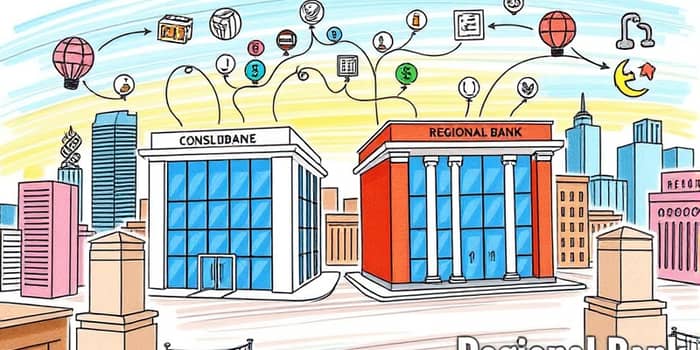
In 2025, the banking sector stands at a crossroads. Regional banks across the United States are joining forces in an unprecedented wave of consolidation, driven by evolving regulations, technological imperatives, and the imperative to build resilience. This transformation reshapes local markets, redefines competition, and offers both opportunities and challenges for institutions and communities alike.
Recent policy changes have relaxed merger guidelines for larger banks, easing the path for big deals. Discussions around revoking certain Dodd-Frank provisions and reinstating stronger merger tests under the Bank Merger Act have signaled openness to scale-driven transformations. Regulatory bodies such as the OCC and FDIC are reviewing approval frameworks, reducing hurdles that once deterred cross-state mergers.
These adjustments make it more feasible for banks with more than $100 billion in assets to pursue bold transactions. By streamlining approval processes, regulators aim to foster stability by encouraging institutions to build capacity and robust governance structures.
High-profile failures, notably the 2023 collapse of Silicon Valley Bank, intensified heightened regulatory scrutiny on regional banks. Supervisory findings for banks under $700 billion in assets surged from 25% in 2016 to 50% in recent years, underscoring the risks of insufficient capitalization and liquidity management.
In response, smaller institutions feel compelled to seek partners that can absorb shocks and satisfy stricter oversight. Consolidation emerges not just as a growth strategy but as a defensive measure to withstand turbulent credit cycles and protect depositors.
Fee compression has turned traditional banking services into commodities. Regional and community banks face dwindling margins on deposits and routine lending. The pursuit of economies of scale through technology becomes essential for sustaining profitability.
Mergers deliver multiple cost-saving levers: branch network rationalization, centralized support functions, and shared investment in digital platforms. Banks joining forces can allocate more resources to advanced fintech partnerships, modernizing payments, and enhancing customer experience without disproportionately burdening their balance sheets.
The first two months of 2025 witnessed 19 announced bank mergers valued at $985.5 million, up sharply from $653.8 million in the same period of 2024. Key regions driving this activity include Texas, the Northeast, Southeast, and Southwest, with pricing ratios (P/TBV) spanning 137% to 159%.
Notable mega-deals set the tone: BMO Financial Group’s acquisition of Bank of the West added $105 billion in assets and expanded its footprint dramatically. Industry forecasts suggest up to seven new megabanks (over $1 trillion in assets) could emerge within a decade, powered by an anticipated 40 major deals each year.
Institutions pursue consolidation for several strategic reasons, chief among them diversified revenue streams across sectors. By integrating payments, brokerage, and fintech services, merged banks can reduce dependence on traditional lending and tap into higher-margin businesses.
Moreover, acquiring advanced digital capabilities offers a shortcut to modernization. For community banks unable to invest heavily in tech, joining forces with a digitally proficient partner accelerates the rollout of mobile banking, automated underwriting, and data analytics tools.
Risk management also features prominently. Banks with $10–100 billion in assets carry commercial real estate (CRE) loan exposure equating to 199% of risk-based capital, compared to 54% for the largest banks. Consolidation helps distribute this risk across a broader asset base, cushioning against sector-specific downturns.
Despite the allure of scale, merger integration can be riddled with pitfalls. Overlapping branch networks necessitate tough choices on closures and staff redeployments. Systems integration efforts often demand hefty IT investments and can disrupt customer service if not managed carefully.
Anticompetitive concerns also loom large. Regulators may require divestitures to preserve local competition, potentially reducing the anticipated cost synergies. Institutions must navigate these requirements while maintaining customer trust and service continuity.
As the consolidation wave gathers momentum, banks should take several practical steps to navigate this environment successfully:
By following these guidelines, institutions can improve the odds of achieving the anticipated cost savings and revenue synergies while minimizing disruption.
For local communities, consolidation offers both promise and uncertainty. Larger entities may deliver superior digital experiences, broader product portfolios, and enhanced risk management. However, branch closures and standardized processes can erode personalized service and local decision-making.
Consumers might benefit from more competitive digital offerings but could face higher fees or less flexible lending terms compared to community-driven banks. Stakeholders must weigh these trade-offs carefully, advocating for models that blend scale advantages with local engagement.
Regional banking consolidation in 2025 represents a pivotal shift in the industry’s landscape. Regulatory realignment, economic pressures, and strategic imperatives drive institutions toward mergers that promise greater resilience and innovation. Yet, the path to integration is fraught with challenges, from antitrust scrutiny to cultural integration.
By embracing rigorous due diligence, clear integration planning, and proactive stakeholder engagement, banks can harness the benefits of scale without sacrificing the customer relationships and community ties that define regional banking. As this consolidation wave unfolds, its ultimate success will hinge on balancing efficiency gains with the enduring value of local presence and personalized service.
References













